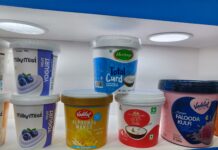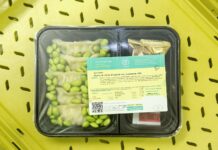In-mold labeling (IML) has in the past couple of decades become popular in industries such as food, beverage, cosmetic, healthcare, pharmaceutical and even automotive. For companies that are looking to increase their consumer appeal and protect their products against contamination and counterfeiting, IML provides the ideal labeling technology.
Injection molding or blow molding?
IML can be achieved via a number of forming methods, the two most popular being injection molding and blow molding. Both methods are effective for labeling applications, but each has a different set of characteristics.
Injection molding involves inserting molten plastic material into a cavity, or mold, which then takes the form of a container, while the label is fitted inside the cavity prior to the plastic being injected. Once the plastic material has been injected into the mold, it is allowed to cool, with the label effectively becoming amalgamated with the container. Among the key benefits that this method offers is the possibility to label all of a polygon-shaped container’s sides at the same time, a procedure which is not possible with glue applied, heat transfer, or pressure-sensitive labeling.
The blow molding process is not dissimilar to blowing up a party balloon. With the heated plastic material being extruded in the form of a tube, a mold is clamped around the pipe as a jet of air is blown out against the cavity walls to take the shape of the container. As with injection molding, the label is applied against the cavity wall and adheres to the formed container, due to the heat activated glue on the labels surface, as it cools down and settles into its final shape. Thanks to this method of molding, the container can be flexed and squeezed with no danger of the label peeling off the surface, therefore resulting in longer durability and also allowing the brand to reproduce higher quality graphics.
The role of static in pinning labels and methods employed
The biggest challenge in IML has always been ensuring that the label is successfully pinned to the mold according to specifications. In-mold labeling companies actually rely on static generation for the delivery of their products.
In the early days of IML, the label would be placed within the mold tool and held into the required position by using a vacuum system. This proved to be a flawed method due to a number of mechanical issues.
As a result, static generation was considered a viable option for fitting labels to mold tools by pre-charging the labels and applying them within the cavity of the injection molding machine. But in order for this method to be successful, certain types of inks, varnishes and materials needed to be used, so that the static charge could hold the label to the injection molding tool surface. Pre-charged labels were also more susceptible to contamination, resulting in higher scrap rates.
The next step in perfecting the IML method was to transfer the electrical charge on to the label whilst inside the mold tool. There are a number of methods to achieve this, such as conductive foams and conductive resins. However, these two methods require close machining tolerances of the cavity and the mandrel, while also incurring high costs.
The more viable alternative for inducing an electrical charge on the label’s surface is pinning heads. While, earlier pinning technologies could result in sparking, which would in turn damage the face of the mold tool. As a result, a smaller, resistive electric pinning system was necessary and that is where Meech’s IML solution comes into play.
Meech’s solution – electric pinning heads and a compact generator
The Meech 994 Hydra is a system of this kind, providing powerful, repeatable pinning with no degradation over time. The components of the 994 Hydra system are easy to mount, as well as being straightforward to connect and disconnect during mold tool changes. The design eliminates the chance of sparking and the possibility of expensive damage to the mold tool. The choice of materials ensures that the problem of potential contamination of the container, sometimes seen with conductive foam based IML systems, is eliminated.
The standard 994 Hydra system consists of resistively coupled distributors connected in series to the new 994CG, a compact generator designed to meet the greater demands of the IML sector.
Conclusion
IML’s key strength is its ability to help maximize packaging appeal, prevent label tampering and guarantee superior adhesion.













i want to buy iml mandrel